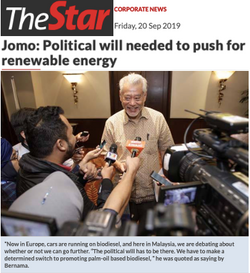- Dec 5, 2024
- 4 min read
Updated: Jan 23
By Jomo Kwame Sundaram
KUALA LUMPUR, Malaysia, Dec 5 2024 (IPS) - Despite uneven economic recovery since the pandemic, poverty, inequality, and food insecurity continue to worsen, including in the Asia-Pacific region, which used to fare better than the rest of the Global South.
Food matters
These trends are not new but have been around for some time. Food security has deteriorated worldwide for a decade and will likely worsen.
Food security measures are more indicative of well-being than traditional poverty measures, which reflect cash incomes subject to inflation and spatial variations. After all, over half of the poor’s incomes worldwide are spent on food.
Due to global heating and rising sea levels, seawater is entering rice fields in Vietnam, Bangladesh, and other countries. Over ten Vietnamese provinces are affected, and less rice production will raise prices, worsening food insecurity.
There have been uneven and modest improvements in health indicators for the Asia-Pacific region, home to three-fifths of the world population. More is needed for preventive health instead of the typical focus on curative services.
In this connection, governments should realise that revenue-financed health systems are more equitable and efficient than either private or social insurance systems touted by all too many consultants.
Grim trends
Today’s macroeconomic situation differs from the Great Stagnation of the 1980s, which especially set back Latin America and Sub-Saharan Africa.
Unlike then, recent downturns have also hit many Asian economies. Recent ostensibly counter-inflationary measures have deepened stagnation in much of the world.
Geopolitics increasingly redirects trade and investments as economic measures are increasingly weaponised. The most vulnerable are most likely to suffer.
The Sri Lankan and Pakistani economies have been in crisis recently as others struggle to avoid similar fates. Debt distress demands attention, but international cooperation is crucial.
After two and a half years of unnecessarily raised interest rates, the US Federal Reserve recently started lowering them at the end of the Northern Hemisphere summer.
Why were those interest rates raised in the first place? Ostensibly due to inflation. But higher prices in recent years have been mainly due to supply-side disruptions, not ‘excessive’ demand.
Raising interest rates has not helped much, as demand-side contraction cannot address supply-side disruptions but only worsens macroeconomic stresses.
Exceptions
Higher interest rates have adversely affected the whole world, including Europe. But unlike other central banks, only the US Fed is committed to achieving full employment.
Such US exceptionalism is part of the problem. However, most economies worldwide have suffered from higher interest rates, which have deepened economic stagnation.
The US has maintained full employment through fiscal policy and has borrowed cheaply from the rest of the world due to its ‘exorbitant privilege’, which is denied to others.
However, Japan’s and China’s central banks have refused to follow the West in raising interest rates. Hence, the pain in economies following their lead has been less severe.
Many governments’ fiscal and debt problems have constrained social expenditures, typically the first victims of budget austerity measures.
Financialization
In recent decades, the Bretton Woods institutions have promoted financialization, often by invoking UN Sustainable Development Goals (SDGs) and climate financing slogans.
With the West’s ‘quantitative easing’ after the 2008 global financial crisis, slogans like ‘from billions to trillions’ encouraged more government borrowing on commercial terms.
Rising interest rates from early 2022 have hit developing countries, forcing macroeconomic authorities to increase debt servicing.
Many countries struggle to service debt worldwide by cutting social spending. This has hit nations facing debt crises and governments trying to avoid more debt distress.
New lessons
During the pandemic, some macroeconomic authorities resorted to policies previously eschewed. Two Southeast Asian nations turned to ‘monetary financing’ of pandemic spending: central banks lent directly to finance ministries, bypassing markets.
The International Monetary Fund also issued special drawing rights (SDRs). Such extraordinary measures are necessary to meet the SDGs and keep temperatures from rising over 1.5oC above pre-industrial levels.
The Banks of Canada and England former Governor Mark Carney, now UN Special Envoy for Climate Finance and Action, has warned that the 1.5oC threshold will likely be exceeded in under a decade.
The world cannot count on some miraculous future invention to reverse irreversible planetary heating processes and their many ramifications.
New realism
Pragmatism demands addressing realities faced. Many such problems are beyond the scope of the ministries responsible for social spending, policy and protection.
Due to ‘reshoring’ and digitalisation, new investment fads will not create enough jobs. New types of socially valuable employment are needed, with many touting the commercialisation of care work.
However, most of our society’s less well-off will be unable to afford commercial care work unless their incomes rise dramatically, which seems unlikely soon.
An ‘all-of-government’ approach remains relevant for developing countries to better cope with and reverse some of the worst social trends.
Trying to do better with the limited resources available for social spending will only be adequate if the ministries responsible for macroeconomic policy, finance, and other related matters cooperate much better than ever.
Improved all-of-government cooperation and coordination work much better with a ‘whole-of-society’ approach to better tackle the social challenges of our times.
Available online here: https://www.ipsnews.net/2024/12/new-approaches-urgently-needed-tackle-resurgent-social-crises/






















